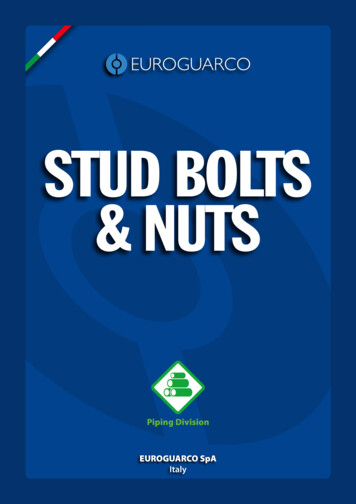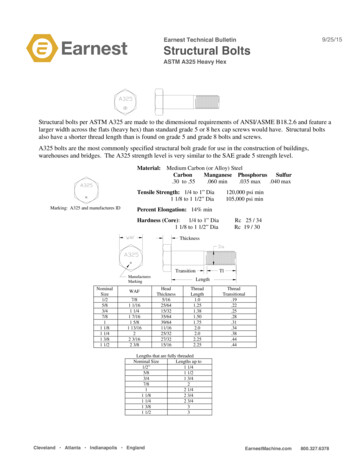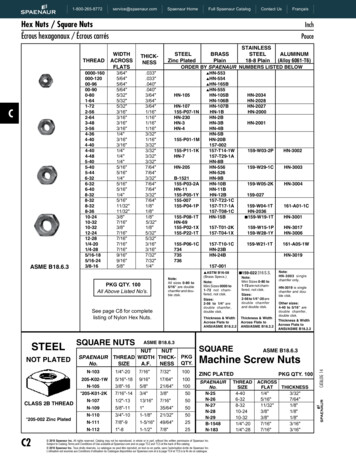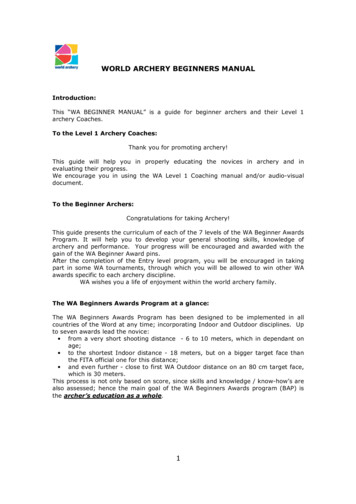
Transcription
The Nuts&Bolts Of Archery:A Guide To Tuning And Shooting Compound Bows1
The Nuts&Bolts of Archery:A Guide To Tuning And Shooting Compound BowsChapter 1: Initial Bow Setup . 3Finding and Setting Initial Nock Point . 3Peep Sight Location and the Nock Sitting on the Side of Your Face . 3Tying in Nock Sets (by Deezlin) . 4Tying a D Loop . 6Finding and Setting Correct Draw Length . 9Draw Length Setting and Posture Clues. 16Draw Length Before and After Stories . 17Posture, Back, Neck, and Shoulder Conditions . 22Chapter 2: How to a Grip Your Bow. 24Bow Hand/Bow Thumb Placement . 24High Wrist, Medium Wrist, Low Wrist and Grip Angles . 30Chapter 3: Arrow Selection . 31Proper Arrow Selection. 31For 3D . 31For Field Archery . 31For Indoor Shooting . 32For Indoor Spots . 32Arrow Spine . 33Spine Rating . 33Arrow Spine Testing Machine . 34Arrow Front of Center (FOC) Balance and Why We Should Care . 35How to Figure Out FOC . 36Chapter 4: Bowstring and Cable Tuning . 38What Does Adding or Removing 4 Twists or Less to the BowstringDo to the Draw Weight of Your Bow. 38What Does Adding or Removing Twists to/from Your StringDo to the ATA of Your Bow? . 38How Many Twists to the Bowstring or CablesIn or Out Constitute Too Many. 39What Does Adding or Removing Twists from Your CablesDo to Draw Weight? ATA? . 39How Does Adding or Removing Twists in Your String in Conjunction withAdding or Removing Twists in Your Cable(s) Affect Your Bow . 40What Effect Does Adding Twists to Your Cables or String Have on YourBrace Height and Draw Length . 41More on Draw Length . 42Chapter 5: Bow Tuning. 44On a Dual Cam Bow, How Do You Advance/Retard the Cams toGain Proper Position and Timing . 44Hoyt Draw Stop Timing (by JAVI) . 46On a Single Cam Bow, How Do You Advance/Retard the Cam toGain Proper Position and Timing . 46The Difference Between Synchronizing and Timing a Cam. 47How a String Should Come Off a Cam at Rest . 48What is Yoke Tuning? How is it Accomplished? Why is it Needed?. . 48Correcting Cam Lean on a Single Cam Bow . 50Correcting Cam Lean on a Dual Cam Bow . 50Binary Cam Tuning Simplified (by Dave Nowlin) . 51Level Nock Travel . 52Nov 15, 2010 edition.rev21
The Nuts&Bolts of Archery:A Guide To Tuning And Shooting Compound Bows2Tiller Tuning . 56Tiller Tuning, the Nitty Gritty Details . 57So, Why Level Nock Travel? Why Tiller Tune? Why Advance/Retard a Cam on Purpose? . 58Chapter 6: Shot Tuning . 60Walk Back Tuning . 60Modified French Tuning. 65Pulling Too Hard Into The Wall . 68Explosive Follow Through Motion - Bow Hand and Riser Jumps FOWARD in a Straight Line . 69Explosive Follow Through Motion - Bow Hand/Bow Arm ROTATES LEFT for RH Shooter . 71Passive Bow Arm . 72Follow Through - Release Side. 72Bare Shaft Tuning and Level Nock Travel . 74Chapter 7: All About Sights and Scopes . 76Adjusting Your Pin Sight . 76Pin Gap Spacing and the Distance Between Your Eye and Your Pins . 762nd Axis . 783rd Axis . 82Clarifiers . 87Chapter 8: Holding Steady. Shooting Weight, Holding Weight, Let off, and Stabilizers . 89Stabilizer Systems and Twisting Motions . 90Short, Medium, Long, and Super Long Stabilizers . 91Total Shooting Rig Weight . 92Chapter 9: Bow and String Maintenance . 93Installing A Center Serving . 93After a Dry Fire or Drop from a Tree Stand. 103Pressing Your Compound Bow . 104My most sincere thanks go out to everyone that contributed to this “guide” with specialthanks to Alan, a.k.a. nuts&bolts, for the contributions he made. Without Alan’scontributions, this document simply would not be what it is as the VAST majority of what iscontained in it is taken directly from his responses on Archery Talk.Nov 15, 2010 edition.rev2
The Nuts&Bolts of Archery:A Guide To Tuning And Shooting Compound Bows3Chapter 1 Initial Bow SetupFinding and Setting Initial Nock PointThe nock point locates your nock on the center serving and locks in the amount of bowstringABOVE the arrow nock and locks in the amount of bowstring BELOW the arrow nock.To set the initial nock point, put your bow into a bow vise, if you have one. While the bow is inthe vise, ensure your string is plumb and set your arrow at 90 degrees to the string (this can beaccomplished with a string and arrow level) with the arrow shaft running through the centerline ofthe two arrow rest holes (also known as Berger holes).Adjust your arrow rest to support the arrow as it runs through the centerline of the Berger holes.If you don’t have access to a bow vise, hold the bow riser vertical, making the bowstring plumb,and set the initial nock point so the arrow is dead level to the naked eye and the arrow shaft isrunning through the centerline of the Berger holes.This is a good starting point.Peep Sight Location and the Nock Sitting on the Side of Your FaceWe want the nock to land on the SAME EXACT spot along the side of your face for each and everyshot. We also want the forward/backward tilt angle of your HEAD to be the same tilt angle for eachand every shot. Ideally, ZERO forward tilt for your head and ZERO backward tilt for your head.Setting the peep sight position on the bowstring helps you do both of these things. It helps keepyour head level (zero forward tilt, and zero backward tilt).RAISE the release hand up or down (do NOT tilt your head to see THROUGH the peep sight).ONLY RAISE YOUR RELEASE HAND so you can CENTER the peep sight and CENTER the roundplastic ring around your pins (pin guard). If you CANNOT SEE the bottom part of the round plasticring around your pins, RAISE YOUR RELEASE HAND and do not tilt your head down to see the entireround plastic ring around your pins when you cannot see the bottom part of your sight ring aroundthe pins.KEEP YOUR NECK FROZEN SOLID; NEVER TILT your head forward or backward to "see throughyour peep sight".You RAISE or LOWER your release hand so the NOCK is sliding UP your face so you can seethrough the peep sight, or, the NOCK is sliding DOWN your face so you can see through the peepsight. You have ADJUSTED where the nock lands on the side of your face so you can see throughthe peep sight WHILE YOUR NECK WAS FROZEN SOLID (no tilting your head forwards orbackwards.zero neck bending) and now you have to ask yourself if this is a comfortable positionfor the nock to land on your face.Nov 15, 2010 edition.rev2
The Nuts&Bolts of Archery:A Guide To Tuning And Shooting Compound BowsIf the answer is no; if the answer is you do not have any facial anchor touch points, MOVE thepeep to a different location on the bowstring and RAISE THE NOCK touching position on the side ofyour face, or, LOWER THE NOCK touching position on the side of your face WHILE your NECK isfrozen (zero bending of the neck).Tying in Nock Sets (by Deezlin)I always use serving nock sets in conjunction with D-loops. I feel this is the best of both worlds.On my hunting bows, I use a serving nock set on top of the nock only and an eliminator cushion orsmall electrical grommet under the nock.My center serving is .022 Brownell Diamondback. I use .026 Brownell Crown serving for my nocksets. In addition to position the arrow's nocking point, nock sets can be use for a number of otherthings, such as tying in kisser buttons, rest pull ropes on drop-aways and peep sight slip collars.In this picture I have already determined the nock position. I have clamped a set of hemostats tothe string to hold the position of the nock. I start the nock set by wrapping the serving around thestring and crossing like the beginning of a square knot and then tighten.After the first knot is positioned and tightened. I wrap the loose ends around the string and crossand then tighten the next knot opposite to the first. I will do this for 10 times to the lower end ofthe nock set and then 4 times to the top.Nov 15, 2010 edition.rev24
The Nuts&Bolts of Archery:A Guide To Tuning And Shooting Compound Bows5After I have completed 10 knots, terminated the lower set by tying a square knot and then will cutoff the ends and melt the end and knot together.I remove the hemostats and complete the top serving nock set. I allow about a total of 1/32 tomaybe a 1/16 of clearance between the nock sets and the nock. This avoids nock pinch at full drawand does not seem to hurt accuracy. This is the completed upper and lower nock sets:Nov 15, 2010 edition.rev2
The Nuts&Bolts of Archery:A Guide To Tuning And Shooting Compound Bows6Tying a D-LoopFirst, a few pictures showing you how to tie a D-Loop:I have completed tying in my D-loop. I melt the first ball on the rope and then wax the ropebefore beginning. I am left handed and if the loop looks backwards too you, it probably is. I do nothold my release tilted too much and I can see little importance as to which is tied which way. But, itis important to tie the knots opposite of each other.Nov 15, 2010 edition.rev2
The Nuts&Bolts of Archery:A Guide To Tuning And Shooting Compound Bows7To take up slack in the D-loop and tighten it, I insert a pair of needle nose pliers to open the loop.(There are pliers available that are designed to assist in the tightening of a D-Loop)Then I open the pliers with both hands to tighten the D-loop.Nov 15, 2010 edition.rev2
The Nuts&Bolts of Archery:A Guide To Tuning And Shooting Compound Bows8This is the completed D-loop. Now, many people feel the nock set should be equal is size so therelease will be behind the nock. However, in actuality, you are pulling slightly up on the D-loop atfull draw. IMO, the release is more behind the nock here than if the nock sets had been equal.Note: I use micro-adjustable rests. With a drop-away, I set the nock square to the rest. With ablade rest or other standard non- drop-away rests, I usually set the nock about 1/8" high. I veryrarely move the nock sets once they are tied. Normally, I make tuning adjustments at the cables orrest for elevation.If you need to move the tied in nock set, you can try threading them up or down the centerserving (like a nut on a bolt); sometimes this works. (Originally posted on Archery Talk by deezlin)Nov 15, 2010 edition.rev2
The Nuts&Bolts of Archery:A Guide To Tuning And Shooting Compound Bows9Q: What's the reasoning behind doing more knots at the bottom vs. the top?A: It changes the center of force for the d-loop. The hook on your release will always find the"middle point" of the d-loop by itself. If the bottom knot is a little bigger, it will put the nock of thearrow slightly above the "middle point" of the d-loop. This results in a slight "down" pressure on thearrow against the arrow rest.Folks who do the larger knot on the bottom of the nock inside a d-loop also feel that it helps theshooter to apply the pulling force more directly behind the arrow.The above nock set is called a tied nocking set or tied nocking point. After they are tied, just coatthem with some superglue.The tied nocking points form a series of “grooves" that mesh with the "grooves" in the centerserving just like a nut going up and down a bolt. No slipping and they spin up and down the centerserving.Tied nock points, or, tied nock sets, allow for very fine adjustment to the nock point of your arrow.(Original answer posted by nuts&bolts on Archery Talk)Finding and Setting Correct Draw LengthThe short answer: the best draw length setting on the bow gets you the BEST arrow groups.The medium length answer: the best draw length for YOU, is where the "float" for your sight pinor scope dot/circle is not too fast (tight pattern, but herky-jerky) and not too slow (large floatpattern, and slow like molasses).The longer length answer:You want the release side elbow and the release side forearm LINED UP directly behind the arrow.Nov 15, 2010 edition.rev2
The Nuts&Bolts of Archery:A Guide To Tuning And Shooting Compound BowsNov 15, 2010 edition.rev210
The Nuts&Bolts of Archery:A Guide To Tuning And Shooting Compound BowsThe BEST for YOU bow draw length setting will allow YOU to get to full draw AND be in a"balanced" upper and lower body posture.Nov 15, 2010 edition.rev211
The Nuts&Bolts of Archery:A Guide To Tuning And Shooting Compound BowsExcellent full draw position.There is room for some improvement in the picture on the left. The picture on the right is anexcellent full draw position.Nov 15, 2010 edition.rev212
The Nuts&Bolts of Archery:A Guide To Tuning And Shooting Compound Bows13The upper body is leaning backwards which is causing extra weight on the rear foot so the hips aremore forwards towards the target. This is no problem when shooting on level ground and is a bigproblem shooting downhill from a tree stand and when trying uphill shots (NFAA field archery, forexample).Nov 15, 2010 edition.rev2
The Nuts&Bolts of Archery:A Guide To Tuning And Shooting Compound BowsNov 15, 2010 edition.rev214
The Nuts&Bolts of Archery:A Guide To Tuning And Shooting Compound Bows15The fellow on the left can get away with this style of posture when shooting indoors, on a levelfloor, but, he will have trouble on uneven ground, severe downhill shots, and uphill shots.The fellow on the right, has an excellent full draw position.Whenever you see that the release side forearm is NOT in line with the arrow (in this example, the"high" wrist, instead of a flat, straight wrist), the holding tension will be ENTIRELY in the upper armmuscles, and VERY LITTLE tension in the larger, stronger BACK muscles. The "HIGH" wrist, is alsoa tell-tale sign that the bow DRAW LENGTH setting is too long.Nov 15, 2010 edition.rev2
The Nuts&Bolts of Archery:A Guide To Tuning And Shooting Compound Bows16Draw Length Setting and Posture CluesThe release arm wrist is up high, the wrist is not in line with the arrow. The wrist is up high, ANDrelease side elbow is down low; tell-tale sign that the bow’s draw length setting is TOO LONG.Another example of wrist too high and release side elbow too low which basically means therelease arm is NOT in line directly behind the arrow:Nov 15, 2010 edition.rev2
The Nuts&Bolts of Archery:A Guide To Tuning And Shooting Compound BowsDraw Length Before and After StoriesBEFORE PHOTONov 15, 2010 edition.rev217
The Nuts&Bolts of Archery:A Guide To Tuning And Shooting Compound Bows18The subject’s posture is out of whack. The upper body is shifted/leaning backwards and there istoo much emphasis on the rear leg/half of the body. When the legs are NOT vertical animbalance/unstable condition is created in the structure of the hip joints due to the angle of the legbones in the upper leg.Photo analysis and recommendations (doctored up photo).BEFORE PHOTOAFTER PHOTOShe is much happier with her shooting and beats her hubby on occasion at the 3D shoots.Nov 15, 2010 edition.rev2
The Nuts&Bolts of Archery:A Guide To Tuning And Shooting Compound BowsTHAT'S how you know that the "new" draw length setting works for you. Try out the NEW drawlength setting for 30 days and if your average scores get better, you are on the right track.Another BEFORE and AFTER story.He shot for YEARS at 29-inch DL. One day, he decided to explore and see if he could get higheraverage scores and decided to post up a picture and ask for advice on AT.Nov 15, 2010 edition.rev219
The Nuts&Bolts of Archery:A Guide To Tuning And Shooting Compound BowsDropped an inch OFF the draw length (went shorter).Still at 28-inches of DL (one-inch shorter, but is now trying a handle release).Nov 15, 2010 edition.rev220
The Nuts&Bolts of Archery:A Guide To Tuning And Shooting Compound Bows21After about 9 months of experimenting and letting things settle down and a bit of advice here andthere Nov 15, 2010 edition.rev2
The Nuts&Bolts of Archery:A Guide To Tuning And Shooting Compound Bows22Over the 9-month period of experimenting his draw length dropped NEARLY 2-inches shorter andhe has been shooting just fine.When you are shooting the BEST scores of your life, then, if you want to experiment further, youexperiment with DL changes 1 twist or 2 twists at a time in the bowstring. At this stage, you aretrying to find that BEST float pattern to increase your x-ring average on a 3/4-inch circle at 18meters (about 20 yards). At this stage, a 1/16th inch draw length adjustment is SIGNIFICANT.DO realize that when shopping for bows, the GRIP ANGLE will change what draw length settingworks BEST FOR YOU. If bow #1 has a very low wrist grip and a 28.0-inch DL works great for bow#1 and you go shopping for bow #2 and bow #2 has a medium wrist grip angle then the DL settingthat works BEST for you may be 1/4-inch or so different.NEVER believe the sticker on the bottom limb when it comes to the DL setting. ALWAYS put thebow onto a draw board and whip out the TAPE MEASURE and get a real world measurement, themeasurement where the pivot point (deepest part of the curve on the grip) to the nock groovetouching the center serving measures 1.75-inches LESS than the DL number on the label.Sometimes, most times (?), the TAPE MEASURE reading will be on the LONG SIDE. 28.0-DL settingon the bow SHOULD give you a TAPE MEASURE reading of 26.25-inches when the bow is on thedraw board.Posture, Back, Neck, and Shoulder ConditionsAll of the prior examples ASSUME zero conditions for neck, shoulders, upper/mid/lower back,elbows, and wrists (etc.).ALWAYS listen to your body and WORK with your body range of motion. If you have a backcondition, OF COURSE, do what you can so that you find what works FOR YOU.Nov 15, 2010 edition.rev2
The Nuts&Bolts of Archery:A Guide To Tuning And Shooting Compound Bows23I have worked with folks who could not lift their bow hand to shoulder height as a result ofrepeated shoulder separations which resulted in limited range of motion. So, we adapt, and find a"more comfortable" lower anchor point for this shooter.Sometimes folks have limited neck rotation flexibility; could be herniated discs (say C1 or C2).Have the shooter rotate their neck to a comfortable position and work around that.If you are a RH shooter and you have discomfort/limited range of motion and to be truly uprightyou find a bias towards the draw arm side more comfortable (slight lean backwards), I would workwith you to find a spacing for your feet and find a hip position/pelvis position where we try to shiftthe center of your lower body (think belly button) a bit more towards your rear foot (right foot).Keep the shoes parallel to each other because this orients the hip joint into the hip socket and intoa more stable configuration.A little LESS FLEX in the left (forward) knee and slightly MORE FLEX in the right (rear) knee.The key to "feeling" balanced with your weight on the left and right foot lies in the shifting of yourbelly button (hip shift) either a skosh more towards or away from the target (sideways shift towardsthe target or away from the target with the lower body) which gets the forward leg more vertical orless vertical.Experiment with this sideways shifting of the lower body to find what "feels" most balanced so thatyour "upper body" lean is comfortable and you "FEEL CENTERED".Nov 15, 2010 edition.rev2
The Nuts&Bolts of Archery:A Guide To Tuning And Shooting Compound Bows24Chapter 2 How to Grip Your BowBow Hand/Bow Hand Thumb Placementhttp://en.wikipedia.org/wiki/Flight dynamicsThat is a link to an animated .gif pattern for the three ways a plane can move through the air.This helps for understanding*ROLL (wing tips go higher and lower)*PITCH (nose of plane goes higher and lower)and*YAWROLL is when a plane uses its flaps on the wing TIPS. The left wing will TIP up or the left wingwill TIP down.PITCH is when the nose of the plane goes straight up or when the nose of the plane goes straightdown.YAW is when the plane is sitting on the ground at the airport and the plane makes a FLAT left turn(wings stay level) or when the plane makes a FLAT right turn (wings stay level).Nov 15, 2010 edition.rev2
The Nuts&Bolts of Archery:A Guide To Tuning And Shooting Compound Bows25Make a fist with your bow hand and place your bow hand on a table. Your bow hand is theairplane; the table is the ground at the airport.Grab a pencil or pen and make a fist around the pen. Keep the pen pointed straight up.POINT your thumb due north (straight ahead) and keep your thumb level, parallel to the table.Now POINT your thumb north east (thumb is pointed off to the right of the target) while the pen isstill pointed straight up.These are adjustments to YAW, or, adjustments to your thumb pointing direction, while keepingthe pen in your fist pointed straight up.With the pen pointed straight up and with your fist still wrapped around the pen, I would like tosee that your thumb is pointed forward in the same direction you want the arrow.Now, with your thumb still pointed FORWARD (due north, let's call it), I would like you to TILT thepen in your fist sideways until you can get a 45 degree TILT on your knuckles AND your thumb isstill pointed forward (due north).When you tilt the pen in your fist SIDEWAYS, you are making a ROLL change in the airplane.Nov 15, 2010 edition.rev2
The Nuts&Bolts of Archery:A Guide To Tuning And Shooting Compound Bows26I cheated and rotated the picture and the two pictures show the thumb pointed "straight ahead".By rotating the picture, I made a ROLL change to increase the angle on the knuckles.When you make a ROLL change to increase or decrease the angle of the knuckles, you changewhere the lifeline of your palm contacts the LEFT EDGE of the grip.With the thumb pointed forwards (same direction as the arrow flight path), you can rotate or ROLLthe hand clockwise and the lifeline will rotate AWAY from the left edge of the riser/grip or you canNov 15, 2010 edition.rev2
The Nuts&Bolts of Archery:A Guide To Tuning And Shooting Compound Bows27rotate or ROLL the hand counter-clockwise and the lifeline will rotate TOWARDS the left edge of theriser/grip.Nov 15, 2010 edition.rev2
The Nuts&Bolts of Archery:A Guide To Tuning And Shooting Compound BowsNov 15, 2010 edition.rev228
The Nuts&Bolts of Archery:A Guide To Tuning And Shooting Compound Bows29This is a nice video clip by Larry Wise. http://www.bowtube.com/media/6/Get A Grip/Experiment with different degrees of ROLL rotation angle. Use whatever angle works BEST foryou. Just remember to keep the thenar eminence (meaty part of the thumb muscle) as relaxed andcushy as you can.Nov 15, 2010 edition.rev2
The Nuts&Bolts of Archery:A Guide To Tuning And Shooting Compound Bows30High Wrist, Medium Wrist, Low Wrist and Grip AnglesThese are pictures of the Shrewd Low Wrist Grip and the Shrewd High Wrist Grip for a Mathewsbow."LOW WRIST" means that the grip angle is darn near vertical; your wrist is very low, closer to theground due to the near vertical angle of the grip which is close to straight up."HIGH WRIST" means that the grip angle is farther away from vertical; your wrist is higher, fartheraway from the ground due to the grip angle.Custom grips are available in a wide range of shapes and a wide range of "angles".Try to have a fully relaxed hand with your fingers naturally curling and zero tension in the fingers.The meaty part of the thumb muscle as cushy as a down pillow and you can feel the bow sinkinginto the thumb muscle AFTER you get to full draw (because the hand is NOT relaxed, whileGETTING to full draw). You must CONSCIOUSLY relax the bow hand thumb muscle in thebeginning to let the thumb muscle get mushy.Allow the bow hand to mold around the grip and get evenly distributed pressure across the top ofyour palm, across the middle of your palm/top of meaty part of thumb muscle, and across thebottom of your palm/bottom corner of the meaty part of the thumb muscle.The bottom of the lifeline of the palm should be just off the left edge of the RH grip.Nov 15, 2010 edition.rev2
The Nuts&Bolts of Arch
blade rest or other standard non- drop-away rests, I usually set the nock about 1/8" high. I very rarely move the nock sets once they are tied. Normally, I make tuning adjustments at the cables or rest for elevation. If you need to move the tied in n










